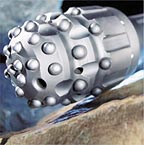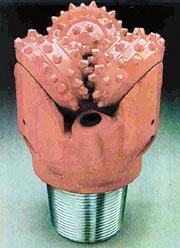This fifth installment of the hammer and bit trends series focuses on two suppliers. Both had promising things to say about improvements in production rates and overall quality and dependability.

Tri-cone Advances
"Ninety-nine percent of our business is tri-cones," says Ken Sentel, owner of KS Bit Inc. in Benton, Ill. While 80 percent to 85 percent of his business is used bits, his sales of new bits has been on the rise. "We buy a lot of surplus new bits and it seems like that keeps on increasing," he explains.Asked which bits are most popular among drilling contractors these days, Sentel relates, "One type or size moves well for a while and then it cycles back and forth. Right now, 12 1¿inch bits are really hot, along with 14 3¿ and 17 1¿. Some of the larger bits - the 22s, 24s and 26s - they aren't moving real well; they've slowed up a bit. Hopefully, that's just part of the cycle for the larger bits and they'll be coming back."
Sentel stresses the quality advancements that have occurred in recent years. "The bits have gotten a lot better compared to the old technologies," he says. "They're lasting a lot longer and the drillers really appreciate it. The PDC (polycrystalline diamond compact) bits especially have been improving. PDC bits seem to be the future; there will be a lot more of those and less of the tri-cones." That's a sobering trend for someone whose business is 99 percent tri-cones. "But," he notes, "Water well drillers and construction drillers - they still are going to want the tri-cones. So eventually, there could be a shortage of tri-cone bits."
Discussing foreign-made bits, he tells us, "The technology and workmanship are not even close to what's being manufactured here in the United States. Some of them are trying to step up, but they're still somewhat lacking. Of course, the price is right. I don't think they'll ever go away, but there's no way they'll ever catch up. They'll have their place. There are places where those bits will work, but on deeper holes or bigger rigs turning more rpms or in harder formations, they just don't hold up well at all."

Hammers and Bits
Todd Taylor is general manager/vice president at Halco America Inc., also located in Benton, Ill. He says drilling contractors are looking for maximum production rates, along with quality and reliability. "Last year we brought 14 new hammers to the marketplace - ranging from 12 inches all the way down to a 1-inch hammer," Taylor points out. "The industry has moved on to new technology, leaving the older stuff behind. The only thing that hasn't moved is the pricing," Then he corrects himself and adds as a disclaimer, "Except when it moves downward.""We sell 99.9 percent new hammers and bits, Taylor explains. "We'll sell demo models if we've got them, but normally, if someone demos a product, it's usually purchased, so that really doesn't come up too often; we don't have much in the way of used products.
"You can't sell out of an empty basket, so we carry more than $2.5 million worth of stock here. We sell to so many markets, we've got 6,000 drill bits sitting here ready to go today. Contractors want to rely on a supplier to get them what they need - and when then need it. We have an ever-increasing number of overseas markets and everybody wants something different because of all the varying conditions. It takes two people to handle our inventory; it's a huge juggling act. And even if we don't have something in stock, we normally can get it to somebody in 10 days - even if we have to build it."
Taylor tells us about the activities of the firm's research and development arm, saying, "We conduct market research and identify a need. If we can come up with something that will give us a payback, we design a product for it." As an example, Taylor points to the mining industry: "For underground gold vein mining, if they can label the vein, they make some small rigs that we can put a 1-inch hammer on so they can go in and drill straighter holes than with a jack leg, which also is much harder work. Productivity is up and they're not killing people. Also, we've come out with a 4-inch grouting hammer so you can drill down and then grout your way back out of the hole. And we kicked off a directional drilling system this past July. It utilizes a percussive device like a hammer. Cost per foot is much less than with a mud motor and you don't have the environmental concerns of the mud and getting rid of it - the system uses air."
At Halco, they've seen the movement toward smaller hammers coming for years. "It's basically due to people building around quarries and quarries being built around people," Taylor explains. "Seismic concerns have drillers going to smaller hammers, smaller blast patterns and less powerful explosions. And some guys are going to smaller hammers just to get a better break in the rock. They'll drill more holes so they have less crusher time. That breaks up the rock into smaller chunks. They don't get the 20-ton boulders they were getting with an 8-inch hole; they're getting 5-ton boulders when they drill a 4-inch hole. But, there is a trade-off. It takes longer to drill the smaller holes because there are more of them. Also, the equipment doesn't wear as well. With smaller equipment, you've got less material there to withstand the wear; penetration rates can suffer sometimes."
Looking ahead, Taylor says, "As the rigs become bigger with bigger air compressors, we're looking at hammers that will perform better and can take advantage of those bigger rigs in an efficient manner. We have a 6-inch and 8-inch deep well series of hammers that undergoes continuous development. This year we engineered our hammers so they can drill under water. When they hit water, they can continue to drill; they don't have to come out to be replaced."
More good news from Taylor: "There still is lots of room for improvement," he declares.
Report Abusive Comment